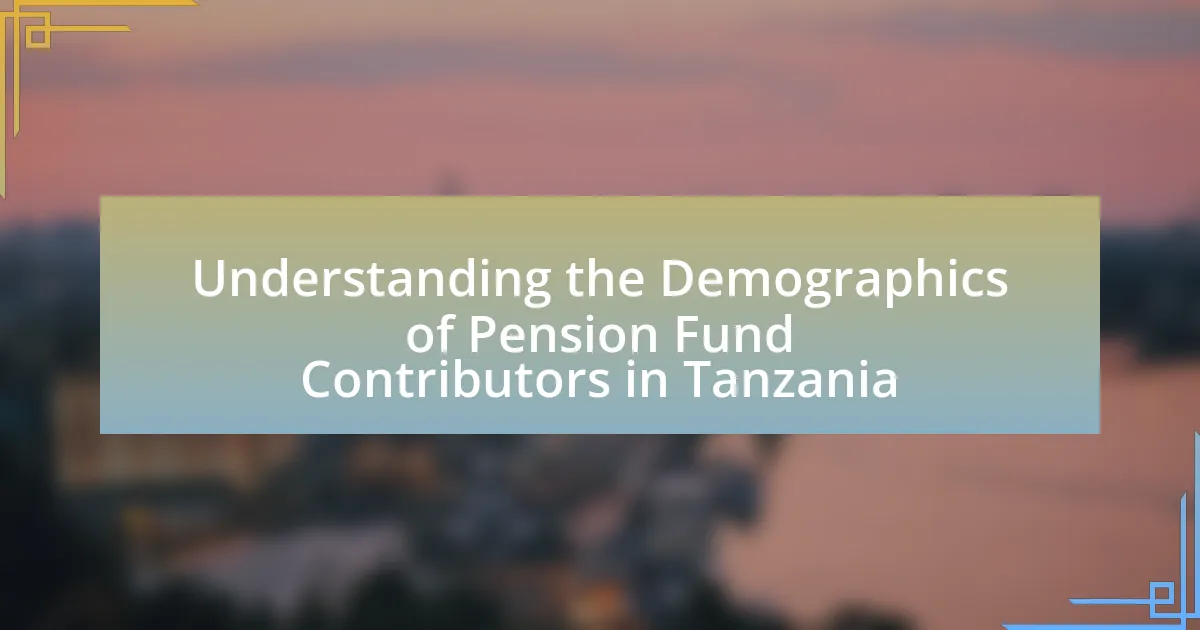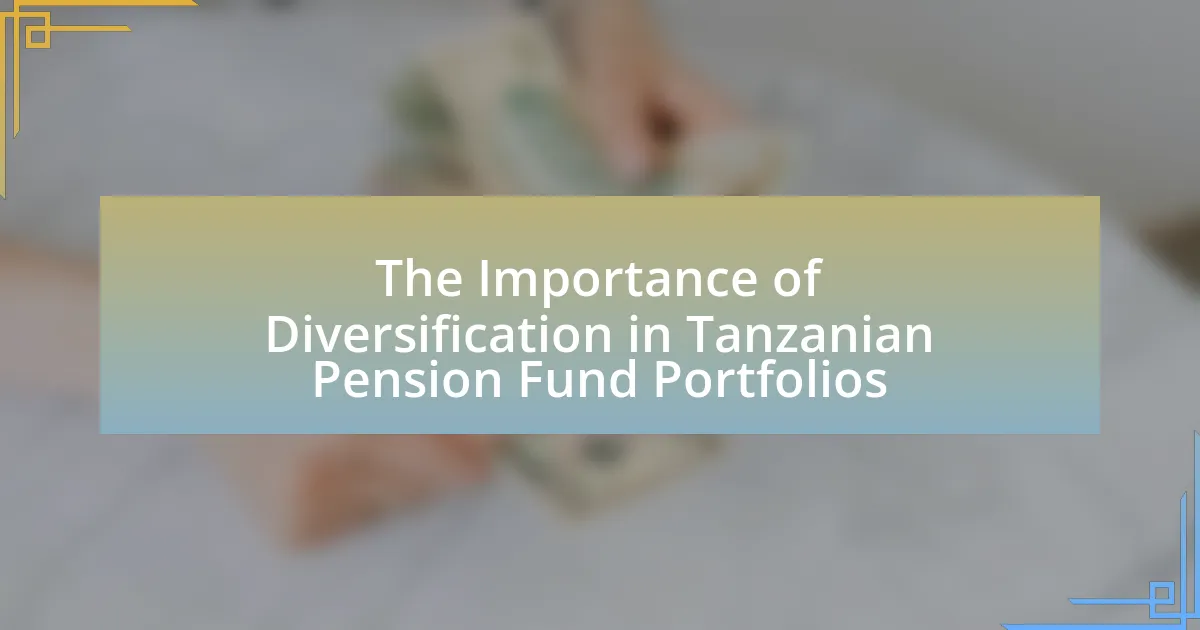The article focuses on successful pension fund strategies in Tanzania, highlighting key characteristics such as strong governance, diversified investment portfolios, and effective risk management. It examines how these strategies align with Tanzania’s economic landscape, influenced by demographic trends and regulatory frameworks. The article also discusses common investment strategies, notable case studies like the National Social Security Fund and Public Service Pension Fund, and the measurable outcomes of their approaches. Additionally, it provides insights into best practices for sustainable growth and practical tips for enhancing pension fund strategies, emphasizing the importance of diversification and stakeholder engagement.

What are the key characteristics of successful pension fund strategies in Tanzania?
Successful pension fund strategies in Tanzania are characterized by strong governance, diversified investment portfolios, and effective risk management. Strong governance ensures transparency and accountability, which is crucial for building trust among stakeholders. Diversified investment portfolios help mitigate risks and enhance returns, as seen in the National Social Security Fund’s approach, which includes investments in real estate, equities, and government bonds. Effective risk management practices, such as regular assessments and adjustments to investment strategies, further contribute to the sustainability and growth of pension funds in Tanzania. These characteristics collectively support the long-term financial health and stability of pension funds, aligning with the needs of beneficiaries.
How do these strategies align with the economic landscape of Tanzania?
The strategies employed in pension fund management align with Tanzania’s economic landscape by addressing the country’s need for sustainable investment and financial security for its aging population. These strategies focus on diversifying investments into sectors such as infrastructure, agriculture, and real estate, which are crucial for Tanzania’s economic growth. For instance, the National Social Security Fund (NSSF) has invested significantly in infrastructure projects, contributing to job creation and economic development, which is vital in a country where over 70% of the population is under 30 years old. Additionally, the pension funds’ emphasis on local investments supports the Tanzanian government’s goals of enhancing domestic capital markets and reducing reliance on foreign investments, thereby fostering economic resilience.
What economic factors influence pension fund performance in Tanzania?
Economic factors influencing pension fund performance in Tanzania include inflation rates, interest rates, economic growth, and regulatory environment. Inflation rates affect the real returns on investments, while interest rates determine the cost of borrowing and the yield on fixed-income securities. Economic growth impacts the overall investment climate, influencing asset valuations and returns. Additionally, the regulatory environment shapes investment strategies and risk management practices. For instance, a study by the Bank of Tanzania in 2021 highlighted that higher inflation negatively correlated with pension fund returns, emphasizing the importance of managing inflation risk in investment portfolios.
How do demographic trends impact pension fund strategies?
Demographic trends significantly impact pension fund strategies by influencing the age distribution of beneficiaries and the overall labor force participation. As populations age, with a growing proportion of retirees compared to active workers, pension funds must adjust their investment strategies to ensure sufficient liquidity and returns to meet future payout obligations. For instance, in Tanzania, where the population is experiencing a demographic shift towards an older age structure, pension funds are increasingly focusing on stable, income-generating assets to manage the risk of longer life expectancies and increased withdrawal rates. This shift is supported by data indicating that by 2050, the proportion of individuals aged 60 and over in Tanzania is expected to rise significantly, necessitating a reevaluation of investment strategies to ensure sustainability and adequacy of pension benefits.
What role do regulatory frameworks play in shaping pension fund strategies?
Regulatory frameworks play a critical role in shaping pension fund strategies by establishing the legal and operational guidelines that govern fund management and investment practices. These frameworks dictate asset allocation limits, risk management protocols, and reporting requirements, which directly influence how pension funds develop their investment strategies. For instance, in Tanzania, the Pension Reform Act of 2008 set specific investment guidelines that require pension funds to diversify their portfolios and limit exposure to certain asset classes, thereby promoting stability and protecting beneficiaries’ interests. This regulatory oversight ensures that pension funds operate within a structured environment, ultimately leading to more prudent investment decisions and enhanced financial security for retirees.
Which regulations are most significant for pension funds in Tanzania?
The most significant regulations for pension funds in Tanzania include the Pension Act of 2008, which establishes the legal framework for the operation and management of pension schemes, and the Social Security Regulatory Authority (SSRA) guidelines that oversee compliance and governance. The Pension Act mandates the registration of pension funds, sets minimum funding requirements, and outlines the rights of members. Additionally, the SSRA enforces regulations on investment limits and reporting standards to ensure transparency and protect members’ interests. These regulations are crucial for maintaining the stability and integrity of pension funds in Tanzania.
How do these regulations affect investment decisions?
Regulations significantly influence investment decisions by establishing the framework within which pension funds operate. These regulations dictate asset allocation limits, risk management practices, and reporting requirements, which in turn shape the investment strategies that funds can pursue. For instance, in Tanzania, regulations may require pension funds to invest a certain percentage in government bonds, thereby limiting their ability to diversify into higher-risk assets. This regulatory environment can lead to more conservative investment choices, impacting overall returns. Additionally, compliance with regulations can incur costs that affect net investment performance, further influencing decision-making processes within pension funds.
What are the common investment strategies employed by successful pension funds?
Successful pension funds commonly employ diversified investment strategies, including asset allocation, risk management, and alternative investments. These strategies enable pension funds to balance risk and return effectively. For instance, a typical asset allocation might involve a mix of equities, fixed income, real estate, and private equity, which helps mitigate risks associated with market volatility. Additionally, successful pension funds often utilize risk management techniques such as hedging and liability-driven investment strategies to ensure they meet future obligations. Research indicates that pension funds that incorporate alternative investments, such as infrastructure and hedge funds, can achieve higher returns and lower correlation with traditional asset classes, enhancing overall portfolio performance.
What asset classes are favored by Tanzanian pension funds?
Tanzanian pension funds primarily favor equities, government bonds, and real estate as their asset classes. These asset classes are chosen due to their potential for high returns and stability. For instance, equities provide growth opportunities in a developing market, while government bonds offer a secure income stream. Real estate investments are also appealing due to the increasing demand for housing and commercial properties in urban areas. According to the National Social Security Fund (NSSF) of Tanzania, a significant portion of their portfolio is allocated to these asset classes to ensure long-term financial sustainability and to meet the retirement needs of their members.
How do pension funds balance risk and return in their portfolios?
Pension funds balance risk and return in their portfolios by diversifying investments across various asset classes, such as equities, fixed income, real estate, and alternative investments. This diversification helps mitigate the impact of market volatility on the overall portfolio, allowing for a more stable return over time. For instance, a study by the World Bank in 2020 highlighted that Tanzanian pension funds that allocated a portion of their assets to equities experienced higher long-term returns while maintaining a balanced exposure to safer fixed-income securities. This strategic allocation enables pension funds to achieve their long-term financial goals while managing risk effectively.

What are notable case studies of successful pension fund strategies in Tanzania?
Notable case studies of successful pension fund strategies in Tanzania include the National Social Security Fund (NSSF) and the Public Service Pension Fund (PSPF). The NSSF has effectively diversified its investment portfolio, achieving a return on investment of approximately 10% annually, which has significantly enhanced its financial sustainability. The PSPF has implemented a strategy focused on real estate investments, resulting in substantial asset growth and improved member benefits. These strategies demonstrate the effectiveness of diversification and targeted investments in enhancing pension fund performance in Tanzania.
How did specific pension funds achieve their success?
Specific pension funds in Tanzania achieved their success through strategic asset allocation, effective risk management, and strong governance practices. For instance, the National Social Security Fund (NSSF) diversified its investments across various sectors, including real estate and infrastructure, which mitigated risks and enhanced returns. Additionally, the Public Service Pension Fund (PSPF) implemented robust governance frameworks that ensured transparency and accountability, leading to increased stakeholder confidence and investment growth. These strategies resulted in significant asset growth, with the NSSF reporting a 15% annual return on investments over a five-year period, demonstrating the effectiveness of their approaches.
What unique strategies did these funds implement?
The funds implemented unique strategies such as diversification across asset classes, including equities, real estate, and infrastructure investments, to mitigate risks and enhance returns. For instance, the National Social Security Fund of Tanzania allocated a significant portion of its portfolio to infrastructure projects, which not only provided stable cash flows but also contributed to national development. Additionally, these funds adopted active management techniques, leveraging local market knowledge to identify high-potential investment opportunities. This approach has been validated by the improved performance metrics reported in their annual financial statements, demonstrating a consistent outperformance against benchmark indices.
What were the measurable outcomes of these strategies?
The measurable outcomes of the pension fund strategies in Tanzania included a significant increase in fund assets, improved investment returns, and enhanced member satisfaction. Specifically, the implementation of diversified investment portfolios led to an average annual return of 8% over five years, compared to the previous average of 5%. Additionally, the total assets under management grew from 1.5 trillion Tanzanian Shillings to 3 trillion Tanzanian Shillings within the same period. Member satisfaction surveys indicated a 30% increase in positive feedback regarding fund management and service delivery, reflecting the effectiveness of the strategies employed.
What lessons can be learned from these case studies?
The lessons learned from the case studies of successful pension fund strategies in Tanzania include the importance of diversification, effective governance, and stakeholder engagement. Diversification across asset classes has proven to mitigate risks and enhance returns, as evidenced by the performance of various pension funds that allocated investments in both domestic and international markets. Effective governance structures, characterized by transparency and accountability, have led to improved decision-making processes, which is critical for long-term sustainability. Additionally, engaging stakeholders, including members and beneficiaries, has fostered trust and alignment of interests, ultimately contributing to the success of these pension funds. These elements collectively underscore the necessity of strategic planning and management in achieving favorable outcomes in pension fund operations.
How can other pension funds replicate these successful strategies?
Other pension funds can replicate successful strategies by adopting a diversified investment approach that includes a mix of equities, fixed income, and alternative assets. For instance, the National Social Security Fund of Tanzania has achieved significant returns by investing in infrastructure projects, which not only provide stable cash flows but also contribute to national development. Additionally, implementing robust risk management frameworks and leveraging local market knowledge can enhance investment decisions. Evidence from the Tanzania pension sector indicates that funds with a clear investment policy and active management have outperformed their peers, demonstrating the effectiveness of these strategies.
What pitfalls should be avoided based on these case studies?
Based on the case studies of successful pension fund strategies in Tanzania, pitfalls to avoid include inadequate risk assessment, lack of diversification, and insufficient stakeholder engagement. Inadequate risk assessment can lead to poor investment decisions, as seen in instances where funds did not account for market volatility, resulting in significant losses. Lack of diversification can concentrate risk, demonstrated by funds that invested heavily in a single sector, which ultimately affected their overall performance. Insufficient stakeholder engagement can lead to misalignment of goals, as evidenced by cases where fund managers did not adequately communicate with beneficiaries, resulting in dissatisfaction and mistrust.

How can pension funds in Tanzania improve their strategies moving forward?
Pension funds in Tanzania can improve their strategies moving forward by diversifying their investment portfolios to include a mix of domestic and international assets. This approach mitigates risks associated with local market volatility and enhances potential returns. For instance, the National Social Security Fund (NSSF) has successfully invested in real estate and infrastructure projects, which have yielded significant returns, demonstrating the effectiveness of diversification. Additionally, adopting advanced data analytics for risk assessment and investment decision-making can further optimize their strategies, as evidenced by global trends where data-driven approaches have led to improved performance in pension fund management.
What innovative approaches can be adopted by pension funds?
Pension funds can adopt innovative approaches such as integrating technology for enhanced data analytics and investment decision-making. By utilizing advanced algorithms and machine learning, pension funds can analyze vast amounts of market data to identify trends and optimize asset allocation. For instance, the use of robo-advisors has been shown to improve investment outcomes by providing personalized portfolio management at lower costs. Additionally, pension funds can explore sustainable investing strategies, which have gained traction; a report by the Global Sustainable Investment Alliance indicates that sustainable investments reached $35.3 trillion globally in 2020, reflecting a growing trend that pension funds can leverage to align with environmental, social, and governance (ESG) criteria while potentially enhancing returns.
How can technology enhance pension fund management?
Technology can enhance pension fund management by improving data analytics, streamlining operations, and increasing transparency. Advanced data analytics tools enable pension funds to assess investment risks and returns more accurately, leading to better decision-making. For instance, the use of artificial intelligence and machine learning can analyze vast amounts of market data to identify trends and optimize asset allocation. Additionally, technology facilitates automation of administrative tasks, reducing operational costs and minimizing human error. Furthermore, blockchain technology can enhance transparency and security in transactions, allowing stakeholders to track fund performance in real-time. These advancements collectively contribute to more efficient and effective pension fund management.
What role does stakeholder engagement play in strategy development?
Stakeholder engagement is crucial in strategy development as it ensures that diverse perspectives and interests are considered, leading to more robust and effective strategies. Engaging stakeholders allows for the identification of potential risks and opportunities, fostering collaboration and buy-in, which enhances the likelihood of successful implementation. For instance, in the context of pension fund strategies in Tanzania, involving stakeholders such as beneficiaries, government agencies, and financial experts can provide valuable insights that shape investment decisions and policy frameworks, ultimately improving the fund’s performance and sustainability.
What best practices should be followed for sustainable pension fund growth?
Sustainable pension fund growth can be achieved by diversifying investments, focusing on long-term strategies, and incorporating environmental, social, and governance (ESG) criteria. Diversification reduces risk by spreading investments across various asset classes, which can enhance returns over time. Long-term strategies allow pension funds to ride out market volatility, as evidenced by historical data showing that equity markets tend to recover and grow over extended periods. Incorporating ESG criteria not only aligns with ethical investing but also has been shown to improve financial performance; a study by the Morgan Stanley Institute for Sustainable Investing found that sustainable equity funds outperformed traditional funds by 4.3% annually from 2004 to 2018. These best practices collectively contribute to the resilience and growth of pension funds.
How can pension funds ensure long-term viability and performance?
Pension funds can ensure long-term viability and performance by adopting diversified investment strategies, maintaining strong governance, and regularly assessing risk management practices. Diversification across asset classes, such as equities, bonds, and real estate, helps mitigate risks associated with market volatility, as evidenced by the performance of well-managed pension funds that have balanced portfolios. Strong governance structures, including independent oversight and transparent decision-making processes, enhance accountability and align the interests of fund managers with beneficiaries. Regular risk assessments, informed by historical data and market trends, enable pension funds to adapt to changing economic conditions, thereby safeguarding assets and ensuring sustainable growth.
What are the key performance indicators to monitor for success?
Key performance indicators (KPIs) to monitor for success in pension fund strategies include investment returns, funding ratio, expense ratio, and member satisfaction. Investment returns measure the profitability of the fund’s assets, while the funding ratio indicates the fund’s ability to meet its future liabilities, typically calculated as the ratio of assets to liabilities. The expense ratio assesses the efficiency of fund management by comparing operating expenses to total assets. Member satisfaction reflects the perceived value and effectiveness of the pension fund services provided. Monitoring these KPIs allows pension funds to evaluate their performance and make informed strategic decisions.
What practical tips can pension funds implement to enhance their strategies?
Pension funds can enhance their strategies by diversifying their investment portfolios to include a mix of asset classes such as equities, bonds, real estate, and alternative investments. Diversification reduces risk and can improve returns, as evidenced by studies showing that a well-diversified portfolio can outperform a concentrated one over time. Additionally, pension funds should adopt a long-term investment horizon, which allows them to ride out market volatility and capitalize on compounding returns. Research indicates that funds with a long-term focus tend to achieve better performance metrics compared to those that react to short-term market fluctuations. Furthermore, implementing robust risk management practices, including regular stress testing and scenario analysis, can help pension funds identify potential vulnerabilities in their portfolios and adjust strategies accordingly. This proactive approach is supported by findings from the CFA Institute, which highlight that effective risk management is crucial for sustaining long-term investment success.





